I was away for two days and returned last evening to an unexpectedly chilly house. I heat with wood when I’m home, but I have a propane heater on a thermostat set for about 50F to keep the house from getting too cold when I’m away, so this was definitely unexpected. I took a look at the thermostat to see what its status was. The display was blank. Not a good sign. I pushed a few of its buttons, any of which should have caused the display backlight to illuminate. Nothing. I opened the unit to check the batteries.
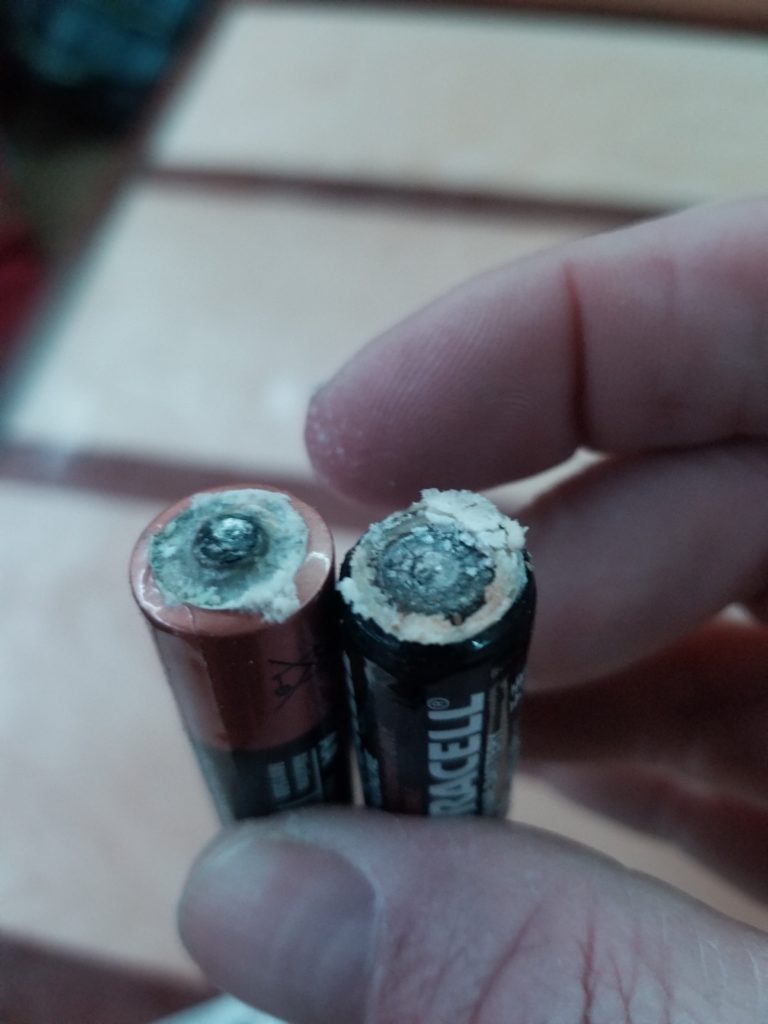
Um. Not so good. Now this thermostat has only been in active service for a few months, but I do know this: I got the thermostat from “stock” in the workshop. I have no recollection at all where it came from, why I have it, or when it was acquired. When it came time to install the propane furnace in the HomeBox, I remembered I had it, so figured: hey, save a few bucks, just use that one. And so it was. I suspect the thermostat came with a pair of batteries and I suspect these are those because it’s 2022 as I write this and upon further inspection of the batteries themselves, I see:
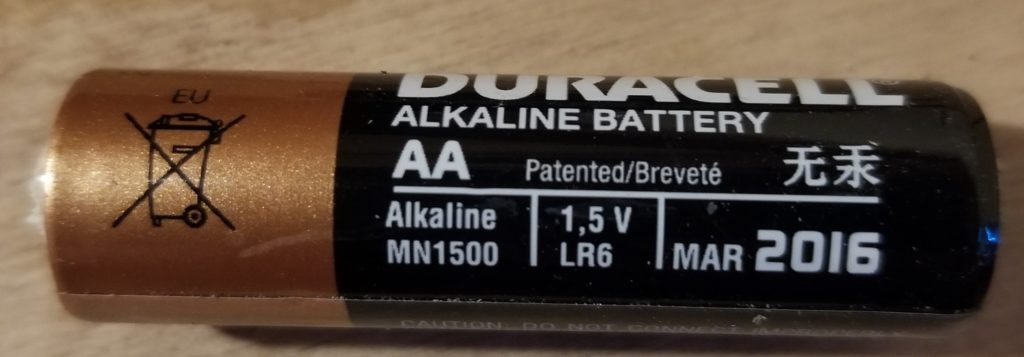
… that the expiration date of the batteries pre-dates the start of construction by over year (July 2017). Since freshness-dating started for batteries about when their shelf lives started to get really good (~10y), I can reasonably assume this AA cell was manufactured in 2006. It is therefore not unreasonable that it should be decomposing 5 years after its expiration date (it is Feb 2022 as I write this) and probably 15y after it was made. However, the failure of this AA cell and its brother left me with a problem.
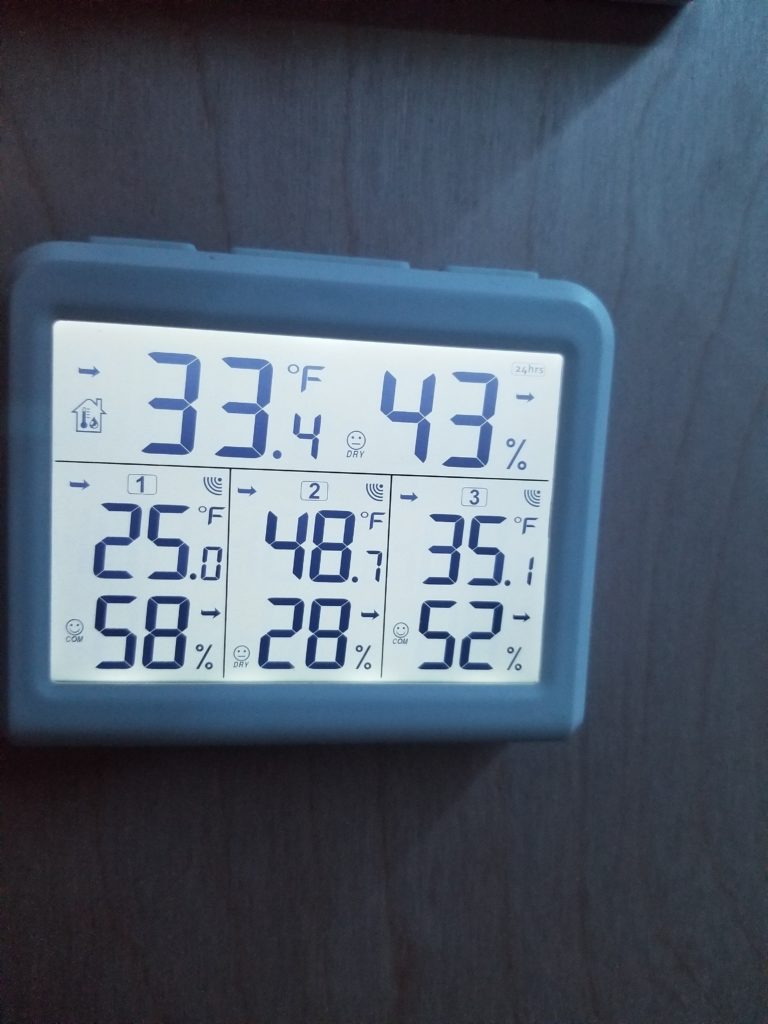
This is my temperature & humidity monitor. The humidity readings aren’t accurate – they were decent when the system was new, but over time, they have become quite unreliable. The temperature sensors, though, are still pretty good. On the bottom row: remote 1 is outside, remote 2 is the office in the W.O.G., remote 3 is the loft in the HomeBox where the power system lives. The top line reports the conditions right there at the display unit, which happens to be mounted in the BeDiLiA. Just above freezing. But that’s at about 4ft from the floor. Down at foot level, it’s a bit colder.
Okay, time to investigate. First things first – turn on some lights – I had just gotten home and it was night. Three lights go on just fine, but the over-table light in my ceiling fan – primary task lighting in the BeDiLiA – won’t turn on. Too cold? Nah, it’s cold, but not so cold a radio transmitter can’t reach 3ft from my hand to the fixture. Wait… the light on the Bednette table lift controller is dark. So are all the lights on the GFCI outlets. Crap. AC power is out, too! SHIT! Are the house batteries totally depleted, too? That would be a big surprise, since power usage is very low in winter when I’m not home (it’s not like the fridge has a lot of work to do) and the batteries in the W.O.G. were full, suggesting there’s been plenty of sun. WTF? Ok, then, new first thing first: find out what’s up with the power system. Everything else depends on that.
The AC inverter is dark! Its main battery breaker is on and there’s no outward reason it should be off. I push the button to wake it up and it comes up fine and stays on. Best guess is it got too cold in the house over the past however long (somewhere between zero and the 2.5 days I was out) and the thing shut down on its own. And once down, it does not come back without intervention. I checked the error log and there wasn’t anything useful in there, so who knows. What I do know, though, is that means my fridge was without power for a while. How’s the food? Is the ice still ice? That’d be a good indication of how things went in there.
The ice is still ice. The food in the fridge smells fine. The nice thing about a power outage in winter, if there is a nice thing about a power outage in winter, is that refrigeration isn’t likely to be a problem. Good, no lost food. Next question: how is my plumbing? The fastest way to answer that is to open a faucet.
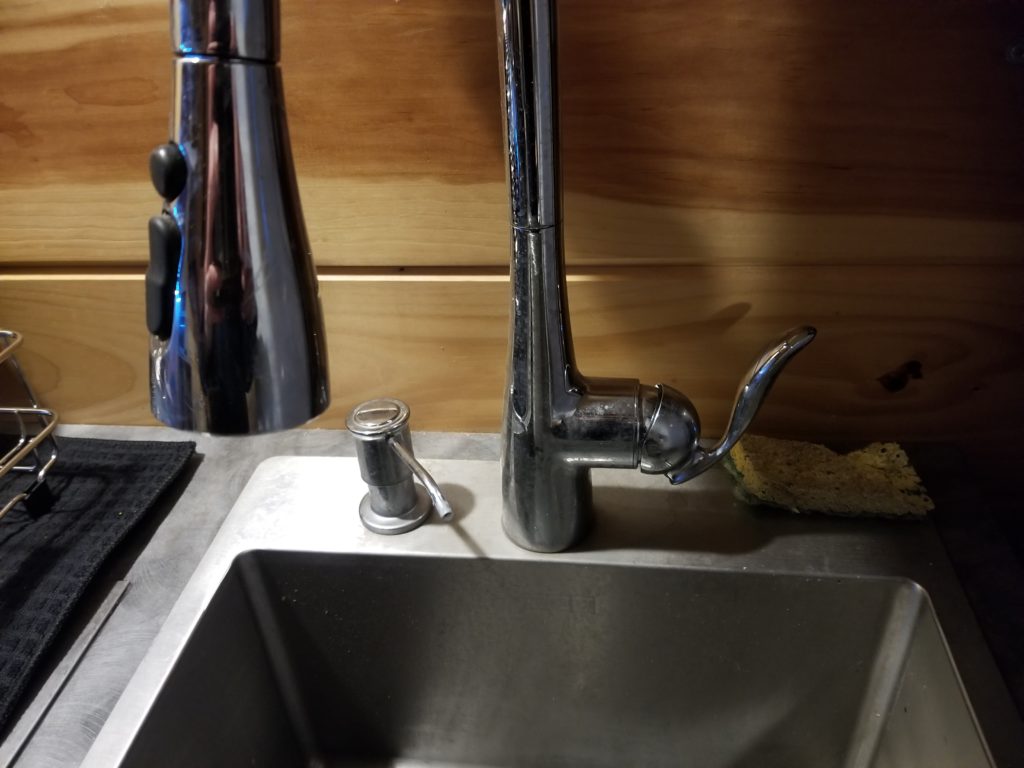
Dry.
Shit.
Pipes are frozen.
I have already replaced the batteries in the thermostat (had to nab one from my computer mouse) – good thing I had some on hand, since it was late Sunday night and not much is open anywhere near here at that time & day. Plan B would have been to simply shunt the thermostat wires, which would have gotten the reheat job done, but obviously wouldn’t shut the heat off at the set temperature. The propane furnace is running and starting to warm up the place. I also light the wood stove and stoke it hot. I need to thaw out these pipes.
There are two things working in my favor here. First, the pipes are PEX – a stiff but flexible polyethylene plastic – which I’ve heard is resistant to freeze bursting. If the brass fittings didn’t break, the pipes are probably okay. The brass fittings are themselves fairly small, so there wouldn’t be much ice in them and that ice could reasonably expand out the ends of the fittings rather than splitting the fitting, so there’s a good chance they’re all fine.
The second thing in my favor is that the water heater actually has its own internal freeze protection system. As long as the water heater has power and propane, it will try pretty hard to keep its internals above freezing. But power was out! But no – AC power was out and the water heater is on the 12VDC system. I have the 12VDC regulator connected directly (with a breaker) to the battery bank. Way to go, Previous Me! I had thought this was prudent, rather than deriving the 12VDC from the AC system (like most things do – think of all those “wall warts” / “power bricks” your various electronics devices require), so in the case of AC failure or even just wanting to perform some service on the AC system, that the DC system could keep running. This is especially relevant since most of my lighting is on the DC system. That was intentional, too – the DC system is simpler and more able to supply power in near-empty cases than the AC system would be. Translation: I can pressurize water, run my space heater, water heater, and most of my lights even when critically low on battery. And if things get super bad, I could run them off my car battery. Or someone else’s. Or something.
Okay, then, now with both heating systems running, it’s just a waiting game to thaw the pipes. It’s imprudent to use a heat gun on the PEX and even if I did, they’re run against the wooden plank walls… not such a good thing to aim a heat gun at unless one wishes to set them alight as well. Having the plumbing on the inside surface also means they’ll see the house heat sooner than if they were in-wall, so that should help. Meanwhile, time to visit the utility loft to see if any of the equipment or fittings up there had any issues. That’s where the fresh water tank lives, along with the supply pressure pump and water heater. Step 1 – feel the carpet.
It’s wet.
Shit.
What’s leaking?
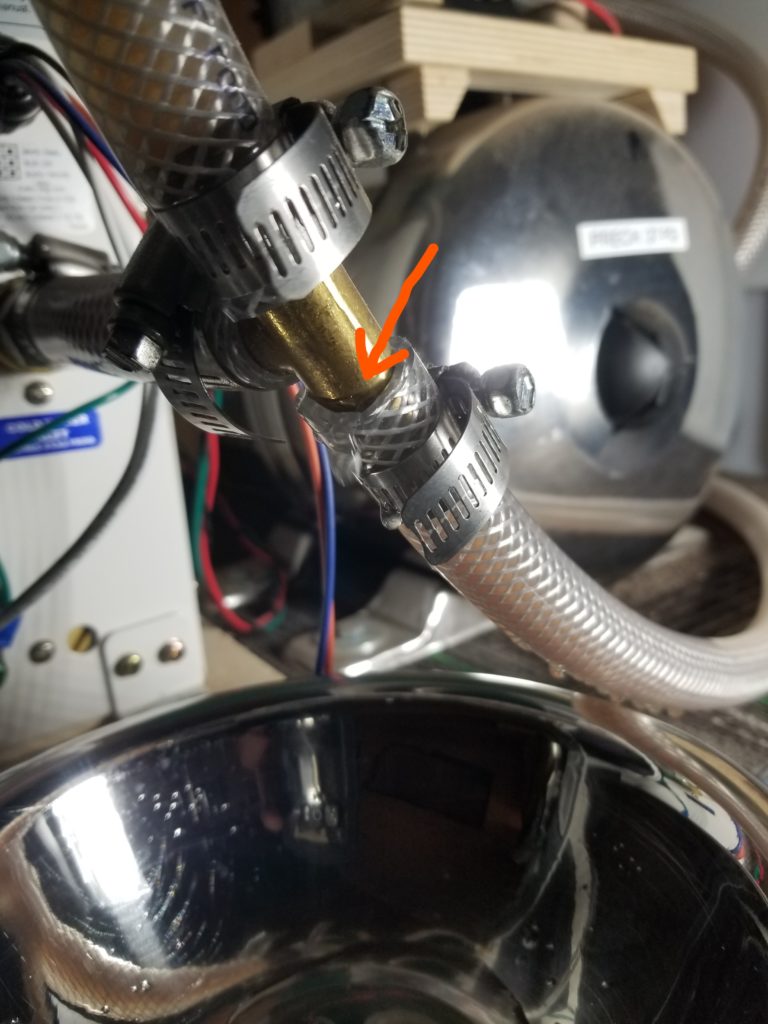
This is. I’m not quite sure why. Maybe some ice formed between the hose and the brass fitting and expanded just enough to make a channel. It’s only dripping, not flowing, but it seems that it had been dripping for quite a while to make the loft carpet that wet. Fortunately, thanks to the Very Good Advice of an old friend, I had turned OFF my water pressure pump before I left, so only as much water as the pressure accumulator could push before it was exhausted got expelled. I’ve never measured it, but I think it’s somewhere between a quart and a half gallon before the accumulator is spent. That’s still a decent puddle but it beats the heck outta the 40 gallons or so available in the tank had the pressure pump been allowed to run!
I tried to tighten the hose clamp, but couldn’t quite stop the leak. Probably because the hose itself was so cold it would not comply around the fitting barbs. As the house warmed up, I went back to this hose clamp and was able to stop the drip.
And then I waited – opened all the faucets and waited. Eventually, a drip, a trickle, and finally flow. All three inside water taps (kitchen sink, tub, bathroom sink) eventually had flow for hot and cold about 3 hours after I started. It’s now after midnight, I’m exhausted (remember I have also just returned home from a weekend away, which involved nearly 300mi of driving home), and now that it isn’t absolutely frigid in the house, it is SO time for bed. Just in case, I turn the water supply pressure pump off and relieve the accumulated pressure, too. I’ll follow up with this all in the morning. I don’t want any puddles when I wake up.
The next morning, everything seems to be okay. No puddles. I cinch up that hose clamp one more time and turn the pressure pump back on. Then I spend two hours writing about it, as I keep an eye on all the things to see that they’re still holding water properly and there aren’t any slow leaks making slow puddles anywhere. So far so good. I think I survived this one with relatively little damage (some wet carpet tiles in the utility loft will probably dry out promptly on their own since it’s now decently arid in the house thanks to the HRV). The jade plants in the cozy loft… the TROPICAL jade plants in the cozy loft… actually, they do not appear to be dead. I’ll check back in a week – sometimes dead plants look like live plants for a little while.
Overall, though, whether or not the jade plants made it, it does appear that the house has survived this bit of freezing, which is good. All because $5 worth of batteries failed. And that is most likely do to their age, which I failed to notice when I installed them.
Is there anything to be done defensively for the future? Good question. A backup thermostat seems like a good idea given the ease of installation, low cost, and effectiveness – especially if it has a different lot of batteries in it! – but really, how likely is this kind of failure to happen again? I mean, there’s plenty of things that can happen and there’s only so much preparedness and redundancy that is appropriate before one has truly gone off the deep end.